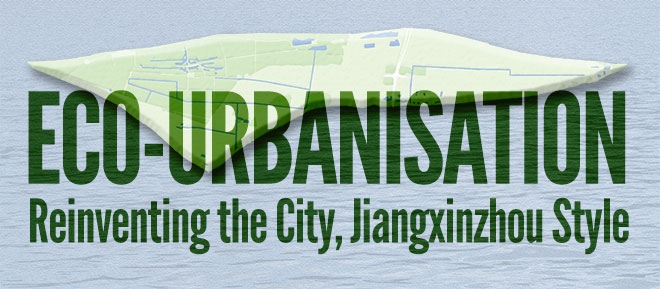Long term residents of Nanjing will be very familiar with Jiangxinzhou, commonly referred to in non-Chinese speaking communities as Grape Island; famed for its vineyards and an associated annual festival plus a way of life altogether more rustic in approach, yet still near to the bright lights of downtown Nanjing, it being situatied just a hop and a skip away in the Yangtze River. Newer arrivals on the other hand, particular those in the real estate or environment sectors, will more likely know it as Singapore Nanjing Eco-Island. The Nanjinger figured it was time to take a look.
The central and lower reaches of the Yangtze River basin are regarded as a globally important eco-region due to the rich biodiversity of its wetland and aquatic biology. Jiangxinzhou sits slap-bang in the middle of it. The natural wetlands of China provide 60 percent of the habitat for migratory birds such as cranes. They form natural dykes and are effective flood protection features. Jiangxinzhou was virtually designed for such.
For us more worldly humans, the island always represented an escape for city dwellers, a voyeuristic chance to step into rural China without being worryingly far from our urban bubble.
A paradise for bikers who flocked to the redwood avenues and riverside paths; that the island was until not so long ago only accessible by ferry served to intensify the attraction. The startlingly fresh local food as well as picking one’s own grapes during the festival (over 50,000 people descend on it each year) were other key draws along with the experience of the ferry itself.
It therefore should not come as any surprise that more than a few hands went up in outcry when the bulldozers and cement mixers started rolling in a few years ago. The first inevitable price of progress was paid in 2010 as the Jiangxinzhou bridge opened to wheeled traffic on the east with the Yangtze River Tunnel to the west. We despaired at the prospect of ridiculously expensive villas and traffic jams ruining what was a perfectly acceptable retreat, to say nothing of the biological habitat. Then, as line 10 of the Nanjing Metro opened up last year in time for the Youth Olympics, and with a station on the island itself, details of what was truly afoot started to emerge.
Urbanisation has come to Jiangxinzhou, yes, but not quite as we expected.
The eco-Island master plan will transform much of Jiangxinzhou into an icon for 21st century Nanjing consisting of low-carbon, knowledge-intensive industry, while keeping the exceptional environment intact. A recreational, working and living environment for upwards of 150,000 people (the island previously supported approximately 20,000) that spans half of the little “continent” is the target by 2020. Partnered up in the remarkable effort are The City of Nanjing, Jiangsu Provincial Government and the Sino Singapore Eco High Tech Island Development Company.
Where the plan, that is at this point still a little horrifying, really comes into its own is on the environmental front. In what is being dubbed the “garden city”, called for are low carbon strategies, such as water reclamation, green energy and sustainable development. Overall, from the outset, the project set in stone guiding principles that would protect, preserve and enhance the existing wetlands on the island. Conserving the wetlands also afforded an opportunity to develop an interesting green concept for the project.
The island was categorised into different zones according to the environmental sensitivity study, with the most ecologically sensitive areas to be protected.
By optimising the landuse efficiency through controlling density and infrastructural modelling in the less ecologically sensitive areas, each area was treated as an eco-system within a larger eco-system.
With environmentally friendly solutions such as these tailored to the island’s specific setting, it is hoped that they will transform it into a self-contained laboratory for high-tech farming, treatment of polluted waterways and ponds, wetland protection and rehabilitation as well as alternative use of by-products from a sewage treatment plant, all joined together by a green transport system.
This is where it all starts getting a little pie in the sky. The proposed Zero-Emission Transportation System (ZETS) will see only electric cars permitted on the island, begging the question what is to be done with the above and all the petrol-driven cars on that big road bridge that leads into a gaping tunnel under the river on Jiangxinzhou itself, or that soon-to-open new tunnel which will be popping its head up on the island before darting through to Pukou?
Nevertheless, there has been no shortage of those wanting to get on board the project, likely to turn the island into a poster child for their very own environment-oriented initiatives.
Top of the list partnering with the development enterprise is Bayer Material Science who is designing low and zero energy buildings that operate on renewable sources, such as hydrogen and solar energy. Other sources of energy are photovoltaic and wind power, with it all mixed together and managed via a smart grid. Of their new relationship with the Singapore Nanjing Eco High-Tech Island Development Company, Dr. Michael Voigt, Director of Bayer ECB China, said, “It’s a win-win for both parties to collaborate on the development of energy efficient buildings. This partnership opens up a golden opportunity for future collaboration in low carbon construction technologies. Apart from its uniqueness, sustainable buildings will add considerable value for the eco high-tech island”.
Jiangxinzhou will also be the first innovative smart city development platform in China for IBM. In place of some of the island’s rustic charms will soon be IBM’s digital Internet technology development centre, an exhibition and cloud computing centre. Elsewhere, modern agricultural and service industries, Information Technology firms and eco-environmental service organizations have all been targeted to expand the island’s economy, and presumably to provide jobs for those living there who have had to leave their petrol-driven cars on the mainland.
Seriously though, keeping people away from cars and encouraging a “walking culture” is indeed part of the mission plan.
Housing in the new development is comprised of two “living communities”; essentially islands within an island that are each approximately 200 metres wide by 400 metres long. Such a size fits in perfectly with the dimensions of Jiangxinzhou itself. Between these two shall sit another island, comprising a commercial centre of mixed-use developments that can accommodate culture and arts, and various entertainment activities. Each “island” is to be relatively independent, yet connected to each other through canals (water taxis are planned), green open space and roads.
So what’s not to love? Well, very little, actually. The vision of the project might well be “A Vibrant Eco-Friendly Island” and “A Global Destination for High-Tech Research, Investment and Talent” or a “a world-class eco high-tech new township on a green intelligent island”, yet much of the tranquil quality of the islet will remain, and for the most part that will be the nice scenic areas. For just as with the hutongs of Beijing and large swathes of the old Shanghai, a good deal of it was frankly demanding of demolition. Arising now from the dust is something akin to Florida, a soulless urban paradise, yet backed up against run-down farms that are slowly lost to the Everglades. The price tag? ¥100 billion, but it’s really quite nice.
This article was first published in The Nanjinger Magazine, June 2015 Issue. If you would like to read the whole magazine, please follow this link.











